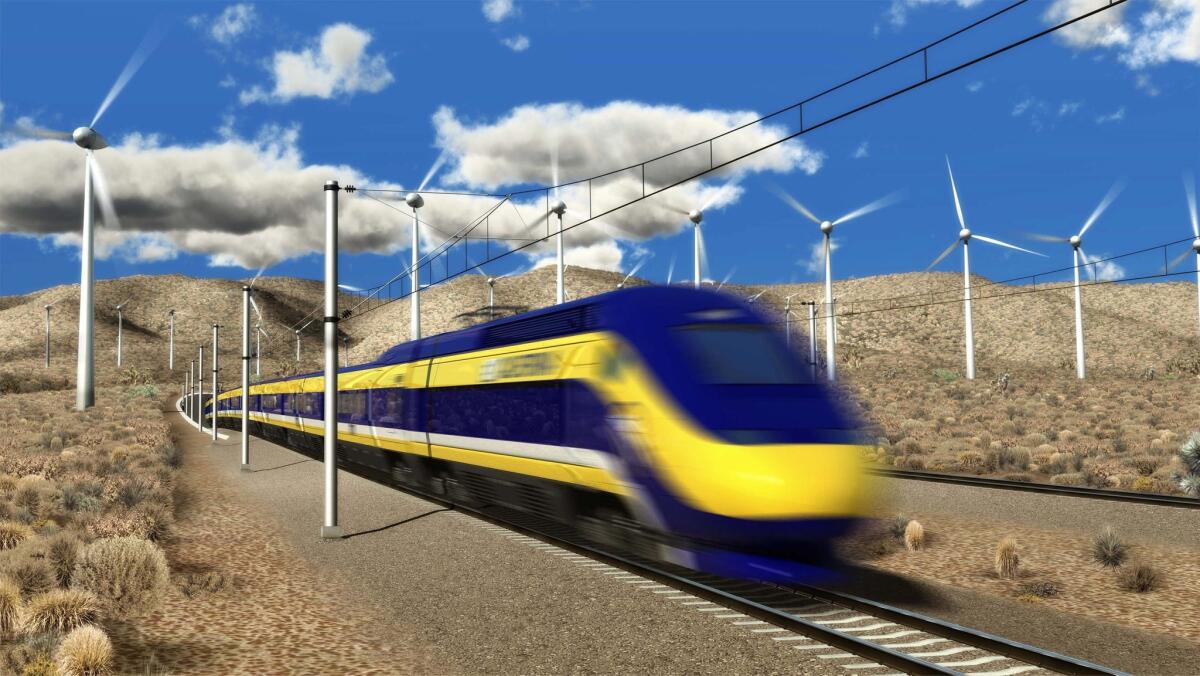Getting California’s bullet train back on track

- Share via
Over the last few weeks, the California High-Speed Rail Authority both lost and won fairly significant battles. It lost when a Sacramento County Superior Court judge ruled that its proposed funding plan violated the voter-approved law, Proposition 1A, that created the agency. The judge has set a hearing to give the state a chance to show that it can comply with the law and environmental reviews.
The state scored a victory when it was decided that the Federal Surface Transportation Board has jurisdiction and would subject the project to federal environmental review rather than California’s version. The federal review process is less far-reaching, so construction approvals would be easier to obtain. But the project is still floundering.
The bullet train could be good for California, but not if the state continues to mismanage the project as it has so far.
SLIDE SHOW: 10 reasons to salute L.A.’s transportation future
Here are three things that Gov. Jerry Brown and Jeff Morales, the rail authority’s chief executive, should do as they try to get high-speed rail back on track with the courts and voters.
Don’t underestimate how betrayed many California voters feel over the project’s revised cost estimates.
When Proposition 1A appeared on the 2008 ballot, the 500-plus-mile rail line’s estimated cost was $32 billion. Shortly after voters approved it, the projected cost jumped $10 billion and then skyrocketed another $58 billion. Brown balked at the $100-billion bill, and the project got downscaled to $68 billion.
All that shilly-shallying eroded voter trust. Concessions to lower costs alienated early supporters by backing away from the high-speed design toward a blended system, which involves sharing track with existing services like Caltrain. Give voters the opportunity to approve a new proposal that fixes the flaws — the wonky cost estimates and unrealistic financial plan, to name two — of the original proposition instead of acting like there’s still a mandate to build the system. There isn’t.
Stop acting like bullet trains shouldn’t have to comply with pesky environmental laws.
Brown’s attempts to exempt the project from environmental review convey, intended or not, state-level indifference to the communities in the construction zones. The federal review process in the National Environmental Quality Act is no picnic. It requires the state to consider community effects in the rail project’s assessment, not just the physical environmental impact.
People dealing with construction day after day and those forced to relocate face life-altering changes. They deserve to have the state obey both the spirit and the letter of laws designed to protect individuals from state coercion. Lawmakers passed environmental review regimes precisely because state agencies rushed through building urban freeways from the 1940s to the 1970s, mostly affecting poor, black neighborhoods. Those actions contributed to riots in Los Angeles and decades of impoverishment in these communities. We can do better than that, and we should.
Brown and Morales should embrace the environmental review process as an opportunity to work with the affected communities. The project has always included provisions for local employment. These and other benefits for the locals should be highlighted. The project should help make things better — right now, not 20 years from now — in the places where the bulldozers are headed.
Stop pretending that the federal government and the private sector are going to pay the bills and instead come up with a realistic, long-term, self-funded financial strategy.
Perhaps the federal government will send more than the $3 billion it has offered, but there is no reason to believe that a deeply polarized Washington is in the mood to add to it. Private-sector investment has supported high-speed rail projects around the world, but usually long after governments have covered the construction costs. A few systems operate well enough to pay back their capital costs — as in Japan — but private investors usually withhold investment until the system is built in major travel markets. So don’t expect anyone to pony up money until service in San Francisco and Los Angeles is set to begin.
The sooner politicians and rail officials accept this reality, the sooner voters can decide on the options, whether it means an additional tax referendum or taking money from other state agencies. One nice idea is to use the proceeds from the state’s cap-and-trade auctions for carbon emissions, though available revenue is limited so far.
How the high-speed rail agency manages the project in the coming year will help determine if next year’s gubernatorial candidates will run on a platform to rid the state of its high-speed rail mess, or whether Brown can leave his successor, or himself, in a strong position to carry the project forward.
Lisa Schweitzer is an associate professor at USC’s Price School of Public Policy; she blogs about urban development and transportation issues at lisaschweitzer.com.
More to Read
A cure for the common opinion
Get thought-provoking perspectives with our weekly newsletter.
You may occasionally receive promotional content from the Los Angeles Times.










